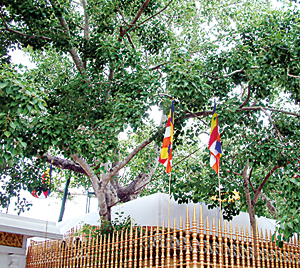Jaya Siri Maha Bodhiya: A priceless gift
View(s):Unduwap Poya falls on December 27
By Rajitha Weerakoon
The gifting of the Buddhist Doctrine and the sacred Bo Sapling by Emperor Asoka to the Lankan Ruler are twin events which remain unparalleled in significance in Lankan history. The Bo Sapling brought by SanghamittaTheri on Unduwap Poya Day in 236 BCE, six months following the introduction of Buddhism, signified the Buddha Dhamma taking root in Sri Lanka.

Sanghamitta Theri however, arrived in Sri Lanka towards the establishment of the Bhikkuni Order which resulted in the elevation of the status of women who while propagating the Dhamma began playing a role in society as literate and socially conscious women.
Accompanying SanghamittaTheri who was bringing with her the Bo Sapling – a right branch of the Sacred Bodhi Tree under which the Buddha attained Enlightenment, were craftsmen of 18 castes, skilled in art, crafts, carving, sculpture, pottery, carpentry, painting, masonry, weaving etc.who were sent by Emperor Asoka to attend to the varied services which had to be performed towards the Sacred Bodhiya – an act which triggered waves of activity, launching a cultural, religious, social and political renaissance unprecedented in Lankan history
The planting of the Bo Sapling which had been the grandest ceremony in the annals of Lanka due to its utmost religious significance also reveal an aspect of political significance to which scant attention had been given. According to the Mahavamsa, those invited to the planting ceremony of the Bo Sapling at the picturesque Mahamegha Uyana by King Devanampiyatissa, the King of Lanka (250-210BCE) had included the ruler of Gramaya – Brahmin Thivakka, dignitaries of the Southern and Northern provinces and rulers of the two southern principalities – Kaajaragama (now Kataragama) and Chandanagama of the Kshatriya clan. Besides provincial leaders, a large number of people from all over the island had streamed into Anuradhapura to participate in this unique ceremony – a ceremony which launched the tradition of worship of the Jaya Siri Maha Bodhiya.
The gathering of varied groups scattered in the island, rulers of principalities and provincial leaders arriving in the capital to participate in the elaborately programmed religious planting ceremony is evidence that for the first time, a united national event based on religion was held and their cordial participation demonstrates that these independent rulers accepted the supremacy of the Anuradhapura King.
Historians point out that inscriptions give evidence of the fact that in the period before the second century BCE, there had existed about thirty provincial units spread out in the island administered by independent rulers. Gamani and his ten sons according to Dhathuvamsa and Mottasakallu inscription of the second century BCE, had ruled Kaajaragama which had been the most powerful principality in the South. It had extended from present Kataragama to Hambantota going beyond Mahaweli river.
Who were these rulers? Some speculate that they were descendants of Rohana – a brother of Queen Baddakacchana. Another view is that as these Kshatriyas identified themselves as “Raja,” they may have migrated from Ghana kingdom in India due to the fact that they opposed the dictatorial rule of the Brahmin kings who were ruling there.
The Kshatriya ruler of Chaandanagama, also an invitee to the Royal ceremony, was a descendent of a brother of Queen Baddakacchana. As they were blood relatives of the Buddha,it was possible that they were already familiar with Buddhism.
However, the five principalities which were set up in the South by five of the brothers of Queen Baddakacchana 200 years earlier, had by this period reduced to 2.
Extending of invitations to provincial rulers to participate in the hallowed planting ceremony gives evidence of efforts taken by King Devanampiyatissa to spread the Buddhist doctrine and Buddhist traditions. But it also served as a means to strengthen relations with the regional rulers. Besides, the invitation to the southern rulers demonstrate that even several centuries after the demise of King Panduvasdeva during whose reign the brothers of Queen Baddakachchana set up principalities in the south, the King desired to maintain goodwill with them.
Devanampiyatissa in fact continued close relations with these rulers as following the planting ceremony, in order to involve the regional leaders actively in the observation of Buddhist traditions,he gifted them the first Bo saplings that sprang from the Jaya Siri Maha Bodhiya in Anuradhapura.
Mahavamsa as well as inscriptions have recorded that these new Bo Saplings were planted in Jambukolapattana in the Jaffna peninsula, in the Brahmana Gramaya ruled by Thivakka, located north of Anuradhapura, in Kaajaragama and Chaandanagama. Bo saplings had been planted elsewhere as well to cover all regions in the island. Buddhist temples as a result sprang in these locations where Bo saplings were planted and the Bodhiya, cherished as a priceless treasure, became the symbol of the presence of the Buddha.
Therefore, while the planting of Bo saplings regionally strengthened King’s political relations with the regional rulers, the king with the gifting of the most precious gift he received from Emperor Asoka launched the tradition of worship of the Bodhiya. As Paul E. Pieris – a non Buddhist had said to the faithful “the influence of what the Bodhiya represents continues to penetrate into the innermost being till the Tree has become human.”
Follow @timesonlinelk
comments powered by Disqus


















